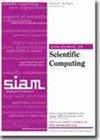AAA Rational Approximation on a Continuum
IF 2.6
2区 数学
Q1 MATHEMATICS, APPLIED
引用次数: 0
Abstract
SIAM Journal on Scientific Computing, Volume 46, Issue 2, Page A929-A952, April 2024.Abstract. AAA rational approximation has normally been carried out on a discrete set, typically hundreds or thousands of points in a real interval or complex domain. Here we introduce a continuum AAA algorithm that discretizes a domain adaptively as it goes. This enables fast computation of high-accuracy rational approximations on domains such as the unit interval, the unit circle, and the imaginary axis, even in some cases where resolution of singularities requires exponentially clustered sample points, support points, and poles. Prototype MATLAB (or Octave) and Julia codes aaax, aaaz, and aaai are provided for these three special domains; the latter two are equivalent by a Möbius transformation. Execution is very fast since the matrices whose SVDs are computed have only three times as many rows as columns. The codes include a AAA-Lawson option for improvement of a AAA approximant to minimax, so long as the accuracy is well above machine precision. The result returned is pole-free in the approximation domain. Reproducibility of computational results. This paper has been awarded the “SIAM Reproducibility Badge: Code and data available” as a recognition that the authors have followed reproducibility principles valued by SISC and the scientific computing community. Code and data that allow readers to reproduce the results in this paper are available at https://epubs.siam.org/doi/10.1137/23M1570508#supplementary-materials.
AAA 连续面上的合理近似值
SIAM 科学计算期刊》,第 46 卷第 2 期,第 A929-A952 页,2024 年 4 月。 摘要AAA 有理逼近通常是在离散集合上进行的,通常是实区间或复数域中的数百或数千个点。在这里,我们介绍一种连续的 AAA 算法,该算法能自适应地将一个域离散化。这样就能在单位区间、单位圆和虚轴等域上快速计算出高精度的有理近似值,甚至在某些情况下,奇异点的解决需要指数簇状的样本点、支撑点和极点。针对这三个特殊域,提供了原型 MATLAB(或 Octave)和 Julia 代码 aaax、aaaz 和 aaai;后两者通过莫比乌斯变换等价。由于计算 SVD 的矩阵行数是列数的三倍,因此执行速度非常快。代码包括一个 AAA-Lawson 选项,用于将 AAA 近似值改进为 minimax,只要精度远高于机器精度即可。返回的结果在近似域内无极点。计算结果的可重复性。本文被授予 "SIAM 可重现徽章":代码和数据可用",以表彰作者遵循了 SISC 和科学计算界重视的可重现性原则。读者可通过 https://epubs.siam.org/doi/10.1137/23M1570508#supplementary-materials 获取代码和数据,以重现本文中的结果。
本文章由计算机程序翻译,如有差异,请以英文原文为准。
求助全文
约1分钟内获得全文
求助全文
来源期刊
CiteScore
5.50
自引率
3.20%
发文量
209
审稿时长
1 months
期刊介绍:
The purpose of SIAM Journal on Scientific Computing (SISC) is to advance computational methods for solving scientific and engineering problems.
SISC papers are classified into three categories:
1. Methods and Algorithms for Scientific Computing: Papers in this category may include theoretical analysis, provided that the relevance to applications in science and engineering is demonstrated. They should contain meaningful computational results and theoretical results or strong heuristics supporting the performance of new algorithms.
2. Computational Methods in Science and Engineering: Papers in this section will typically describe novel methodologies for solving a specific problem in computational science or engineering. They should contain enough information about the application to orient other computational scientists but should omit details of interest mainly to the applications specialist.
3. Software and High-Performance Computing: Papers in this category should concern the novel design and development of computational methods and high-quality software, parallel algorithms, high-performance computing issues, new architectures, data analysis, or visualization. The primary focus should be on computational methods that have potentially large impact for an important class of scientific or engineering problems.

 求助内容:
求助内容: 应助结果提醒方式:
应助结果提醒方式:


